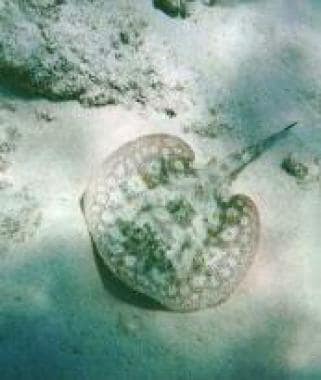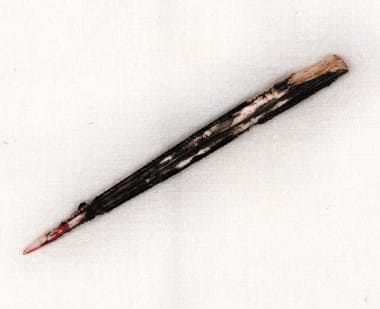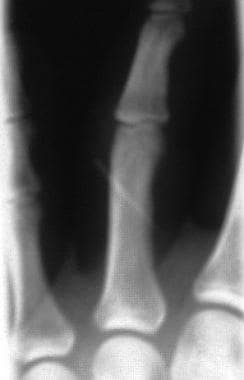Practice Essentials
Stingrays (ie, elasmobranchs) are bottom-dwelling cartilaginous fish that have a flattened body, one or more stout spines on the tail, gill slits on the lower surface of the head, teeth modified into 2 large crushing plates, and no dorsal fin. They are not aggressive toward humans; however, injuries from these animals are very common. Stingrays are shown in the images below.
Stingrays from the northern hemisphere make up the family Dasyatidae. These fish are marine creatures (ie, live in salt water) but also have been found in brackish waters and bays. Another ray family (Potamotrygonidae) [1] contains poisonous species known as freshwater stingrays. These freshwater stingrays live in lakes and rivers of South America.
See Deadly Sea Encounters, a Critical Images slideshow, to help make an accurate diagnosis.
Also see Cutaneous Manifestations Following Exposures to Marine Life.
Prognosis
Stingray injuries (eg, puncture wounds, lacerations, envenomations) tend to have good outcomes. If patients do not develop infection or other complications, they can expect to have minimal pain in 24-48 hours and healing within 1-2 weeks.
History
Stingrays commonly are found lying half-buried in the sand or mud of coastal temperate areas.
Injuries tend to occur when an unsuspecting person steps on the fish, causing the animal to reflexively strike the person with its defensive mechanism.
The stingray's tail has one or more barbed stingers and two ventrolateral venom-containing grooves that are encased in an integumentary sheath. The tail is thrust into the victim, usually in the foot or lower leg, producing a deep jagged laceration from the serrated spine(s). A stingray spine is shown below.
The stinger apparatus then injects a protein-based toxin into the wound, causing immediate intense (even excruciating) pain in the victim. Injury may occur without envenomation because many stingrays lose or tear the integumentary sheath covering the venom glands.
This subject has taken on worldwide interest due to the unfortunate death of the celebrity wildlife naturalist Steve Irwin (also known as "The Crocodile Hunter") on September 4, 2006. Irwin was filming a documentary on stingrays in Queensland, Australia, when he reportedly suffered a puncture wound of the heart from a stingray barb. He died on the scene. This is a very rare injury since most stingray puncture wounds occur on the extremities and are superficial.
Diagnostics
No laboratory studies are indicated in the usual case of stingray injury.
Plain radiography should generally be used to obtain images of the injured area in at least 2 planes. Plain radiography is useful to rule out the presence of any foreign bodies, such as retained components of the barb mechanism, as well as to differentiate injuries caused by some other object (eg, sharp object stepped on in the water, causing a retained foreign body). [2]
A stingray barb is shown in the radiograph below.
In a cadaveric comparison of magnetic resonance imaging, plain radiography, and ultrasound in the detection of stingray barbs in the foot and ankle, plain radiography had the highest sensitivity (94%). MRI showed the greatest specificity (100%). [3]
Treatment
As soon as possible, immerse the affected body part in very hot water (as hot as the patient can tolerate without scalding) or apply a hot pack to the affected body part. Heat rapidly decreases the patient's pain, presumably due to the direct effect on the poison.
See Emergency Department Care.
Prevention
When stepped on, the stingray reflexively strikes out, causing the injury to the person who stepped on it. Advise patients to walk in the shallow areas of the beach with a shuffling gait. This is effective in causing stingrays to move away and help decrease the possibility of accidentally stepping on a stingray.
Pathophysiology
Stingray venom is highly complex chemically. For example, analysis of Potamotrygon motoro (ocellate river stingray), has shown the presence of hyaluronidase, cystatin, and calglandulin. The hyaluronidase present is unique to stingrays and differs from the hyaluronidase found in the venom of bony fish species. There is large variation in the composition of stingray venom, even among related freshwater species. [4]
In rodent models, it has been discovered that P motoro venom causes both neurogenic and inflammatory pain. Neurokinins, calcium, and histamines are among the neuroinflammatory mediators in the venom that contribute to the extreme pain associated with P motoro stings. [5] Kirchhoff et al found from analysis of 5 stingray venom transcriptomes that toxins present in these venoms responsible for hyperalgesia primarily activate the inositol-3-phosphate receptor cascade. This activation causes the release of intracellular calcium. There was also evidence for synergistic activity among toxins, with tumor proteins and nerve growth factors working in unison to activate pain-signaling pathways. [6]
Epidemiology
According to the National Capital Poison Center, there are approximately 1500-2000 stingray injuries reported in the United States each year. [7] More detailed statistics are unavailable, but several international surveys of local incidence have been undertaken. A survey of 392 marine toxicology cases reported to a South African poison control center from 1995-2014 revealed 36 (9.2%) were regarding stingray envenomations. [8] A separate survey of 300 adults living in the Tapajos River Basin of Brazil revealed that 19 (6.3%) respondents had experienced stingray injuries in the past 12 months. [9]
Patient Education
Following is an example of discharge instructions that could be given to patients after treatment of stingray injuries.
Because so many areas of water are nearby, many types of injuries associated with being in or near the water are encountered. These injuries may occur while fishing, walking on the beach, playing in the surf, diving, or working with a home aquarium.
Stingrays often cause lacerations and puncture wounds when the tail whips up and thrusts its barbed spine into the victim, depositing venom (poison). The pain is severe immediately and worsens over the next hour. The pain may last 48 hours. Although rare, deaths have occurred from stingray injuries.
As soon as possible, the wound should be soaked for 30-90 minutes in very hot water (as hot as can be endured without causing burns). The heat inactivates the poison and dramatically relieves the pain. The physician may prescribe pain medication. Also, because the risk of infection is very high, antibiotics are given to prevent infection.
Despite the best of care, any wound can develop infection or other complications. If any of the following occur, it is recommended that patients call their own doctor, the referral physician, or clinic (If a physician cannot be contacted, return to the ED is advised.):
-
Wound drainage increases, shows pus, or develops a foul odor
-
Wound bleeds heavily
-
Wound becomes more sore or swollen
-
Wound develops increasing redness, or red streaks develop
-
A fever develops
-
Wound does not appear to be healing properly
-
Any other new or worsening symptoms that are of concern
-
Typical stingray puncture wound on a foot, approximately 60 minutes after injury. Photo by John L. Meade, MD.
-
Stingray barb in forearm. Photo by John L. Meade, MD.
-
Stingray barb broken off in ring finger. Photo by John L. Meade, MD.
-
Spine removed from stingray injury. Image courtesy of Scott Plantz, MD.
-
Stingray.
-
Stingray.













